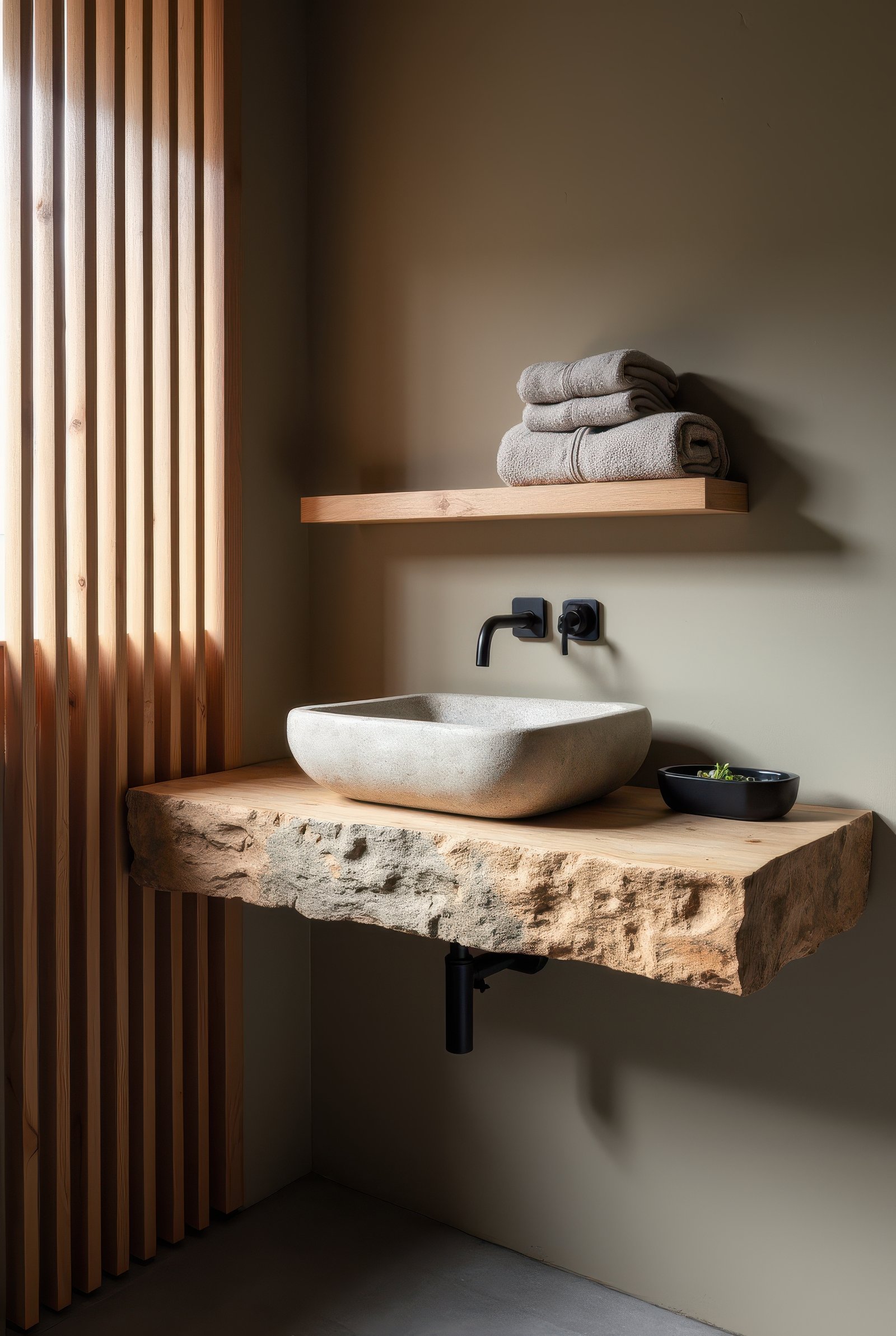Japandi Bathroom—ever heard of it? I first stumbled across this style when I was desperately trying to make my tiny apartment bathroom feel less like a cave and more like a calm retreat. It mixes the sleek simplicity of Japanese minimalism with the warm coziness of Scandinavian design. Sounds dreamy, right?
In this intro, we’ll explore three key insights:
- How pairing clean lines with natural materials transforms even the smallest space.
- Why soft, neutral colors can make your bathroom feel bigger (and way more relaxing).
- The easy tricks for decluttering without sacrificing personal style (yes, I’m talking to my fellow product hoarders).
Ready to give your bathroom a little Japandi makeover? Let’s dive in.
Introducing the Japandi Bathroom: Where Minimalism Meets Functionality
Have you ever looked at your tiny bathroom and thought, “I wish this felt like a serene getaway instead of a cramped afterthought?” Same here. That’s where the Japandi Bathroom concept swoops in to save the day. It mixes the clean, minimalist style from Japan with the cozy, functional design from Scandinavia. The result? A soothing little spa in your home—even if that home is a pint-sized city apartment.
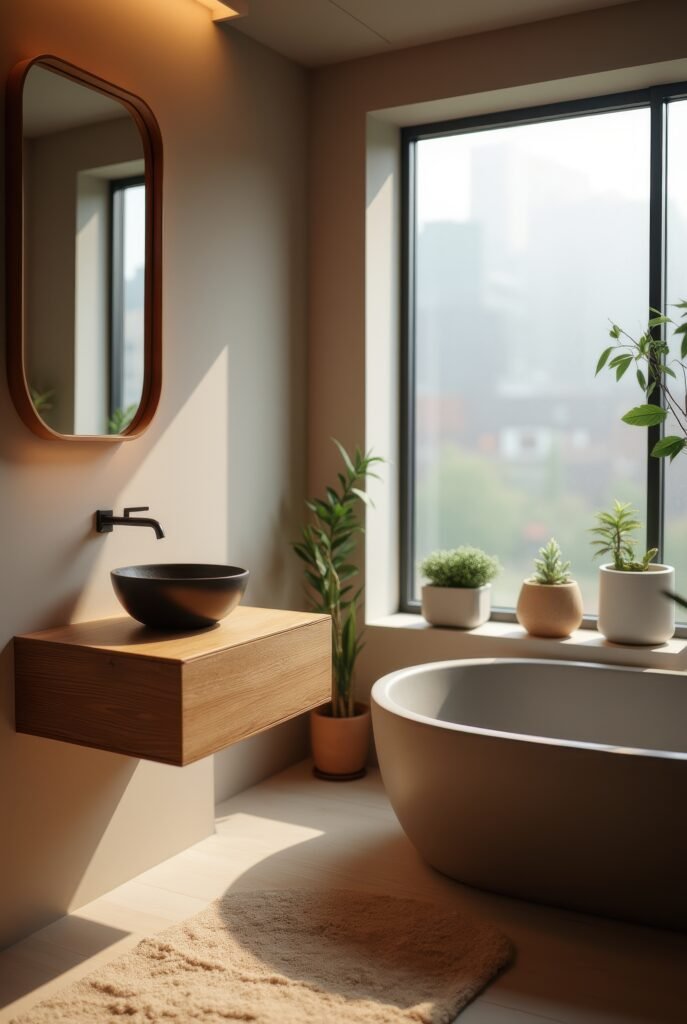
Why Japandi Is So Appealing?
It’s all about balancing form and function. In big cities (with even bigger rents), every square inch matters. Japandi embraces an idea that’s half “less is more” and half “make it useful.” So you get elegant, fuss-free design that also works hard for you.
Cultural Foundations of Japandi
Japandi design has roots in two awesome philosophies: Japanese wabi-sabi and Scandinavian hygge. Think of them like two best friends who just happen to perfectly complement each other in a bathroom setting.
Wabi-Sabi Philosophy in Modern Bathing Spaces
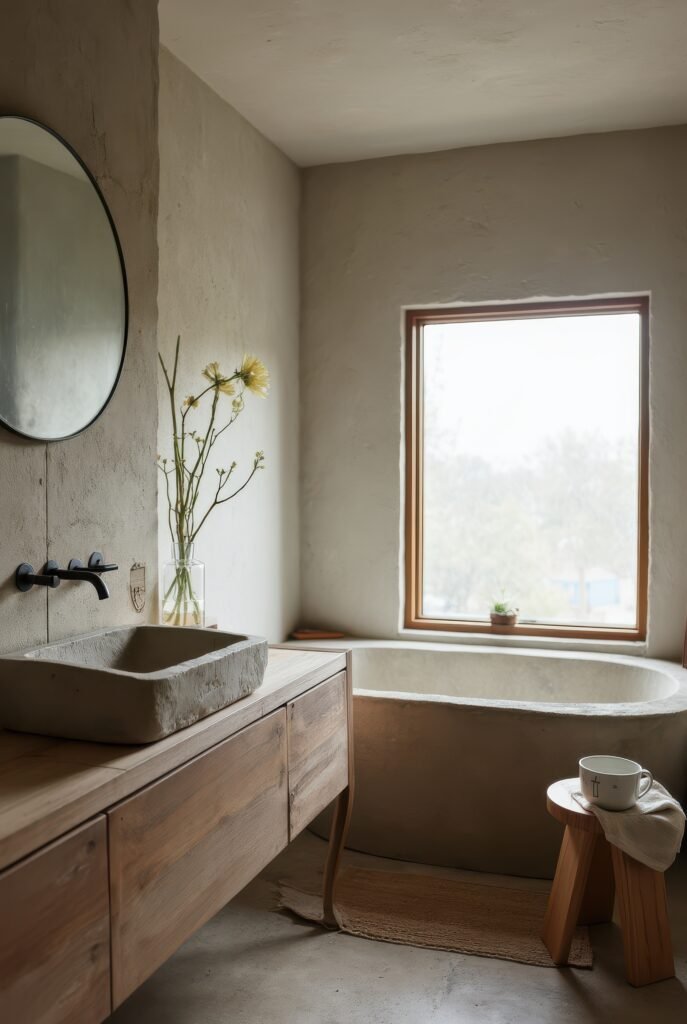
Wabi-sabi is all about finding beauty in imperfection. It says, “Don’t fret over flaws; embrace them.” Imagine a sink with a subtle crackle in its glaze. That tiny imperfection becomes a conversation piece instead of a flaw. I once tried to fix a chipped tile, only to find it looked more interesting after I stopped worrying about it. That’s wabi-sabi at work.
- Embrace Natural Materials: Stone basins, unvarnished cedar bath trays, and pebble-lined shower floors bring nature indoors.
- Mindful Rituals: A soaking tub by a small window (or even a mirror if you have no window) encourages you to pause, breathe, and unwind.
Scandinavian Hygge for Small Bathrooms
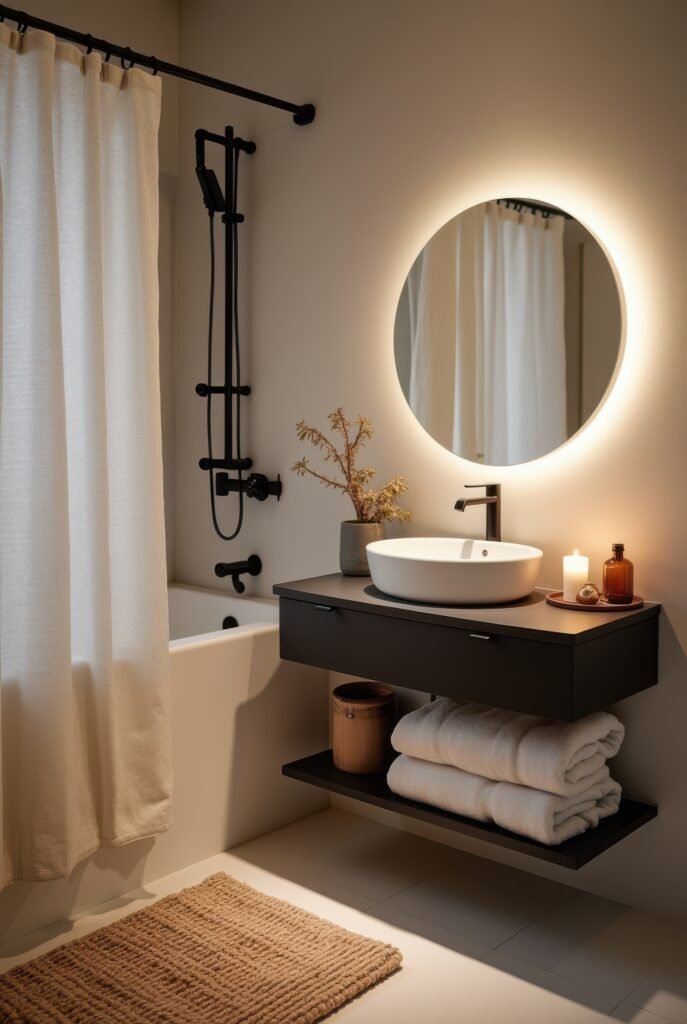
Hygge means comfort through simplicity. Think soft towels, gentle lighting, and a warm place to land on a chilly morning. That coziness can transform a cramped urban bathroom into a haven.
- Light as a Life-Saver: Use mirrors and well-placed lights to make a dark, windowless bathroom feel bright.
- Tactile Layers: Combine textures like thick waffle-knit shower curtains, wooden bath mats, and linen towels.
- Keep It Accessible: Hygge design doesn’t have to cost a fortune. Simple shelves from IKEA or secondhand furniture can work wonders.
Bridging Two Worlds in Your Bathroom
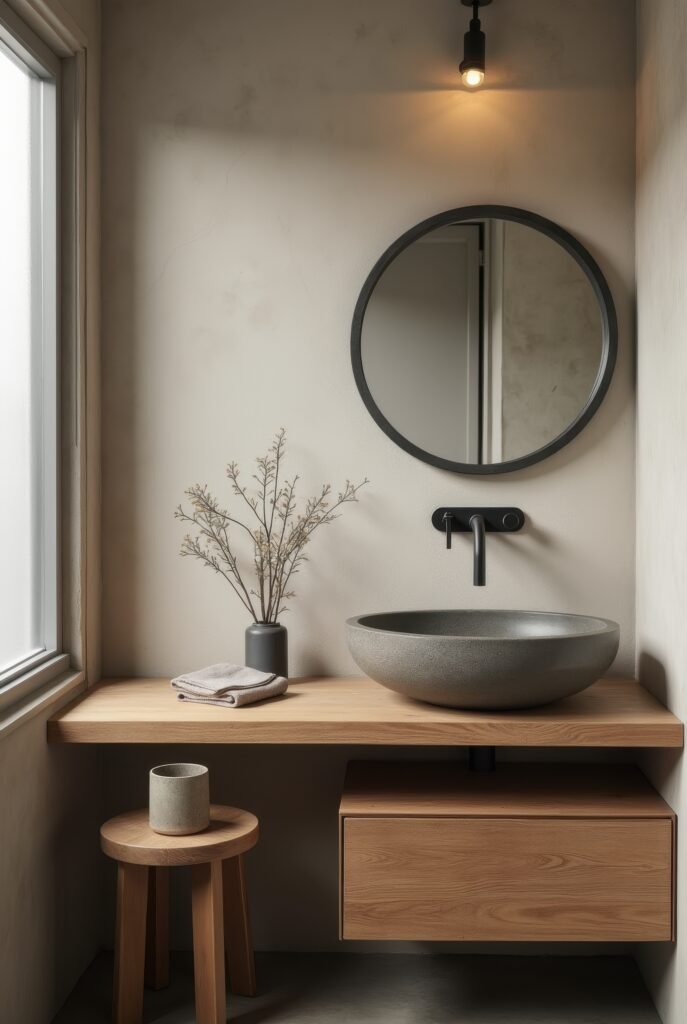
When you blend these ideas, magic happens. A handcrafted ceramic sink (wabi-sabi) pairs perfectly with a sleek, wall-mounted vanity (Scandi function). Suddenly, your tiny bathroom feels like a curated art piece—without being showy. Plus, it’s designed for real life, with hidden storage and easy-to-clean surfaces.
Apartment-Centric Advantages
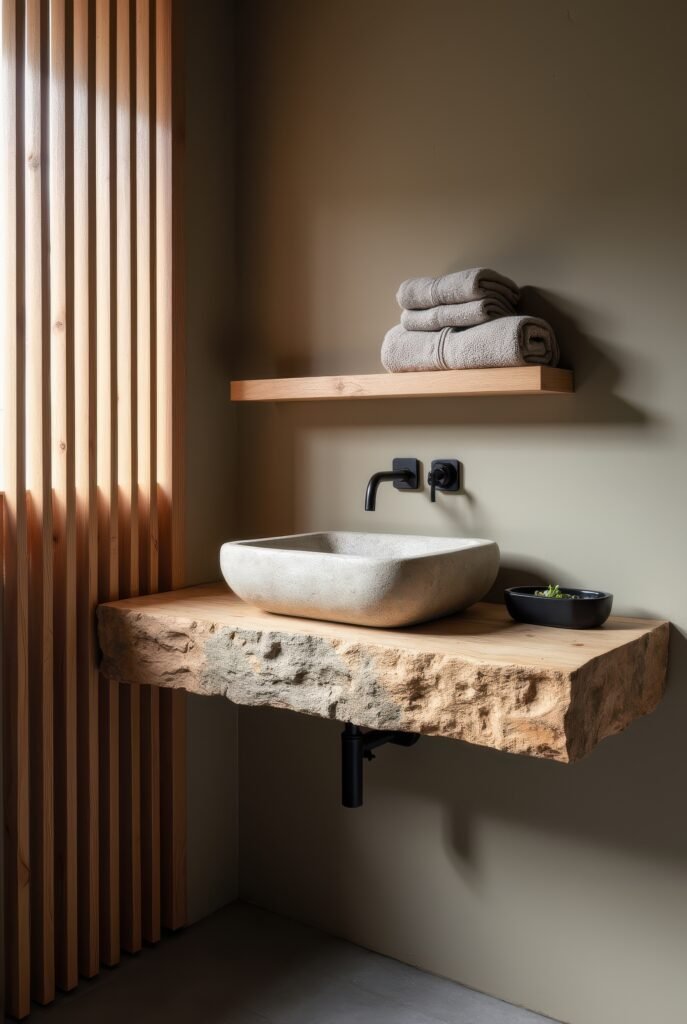
If you’re living in a city like me—where space is tight—Japandi’s a lifesaver. Here’s why:
- Clutter Resistance: Stick to “less but better.” So instead of five different soap bottles on the counter, maybe just one pretty dish for a bar of natural soap. Hidden cabinets keep the rest out of sight.
- Light Optimization: Frameless mirrors and reflective faucet finishes make a small room look bigger. I once replaced a bulky medicine cabinet with a frameless mirror, and it felt like I’d gained an extra foot of space overnight.
- Tactile Contrast: Mix smooth stone with rough-hewn wood. It sounds fancy, but really, it’s just about creating tiny moments of interest—like a stone basin on a wooden vanity. This trick makes a small room feel curated rather than cramped.
Core Principles of Japandi Bathroom Design
The “Less But Better” Approach to Fixtures
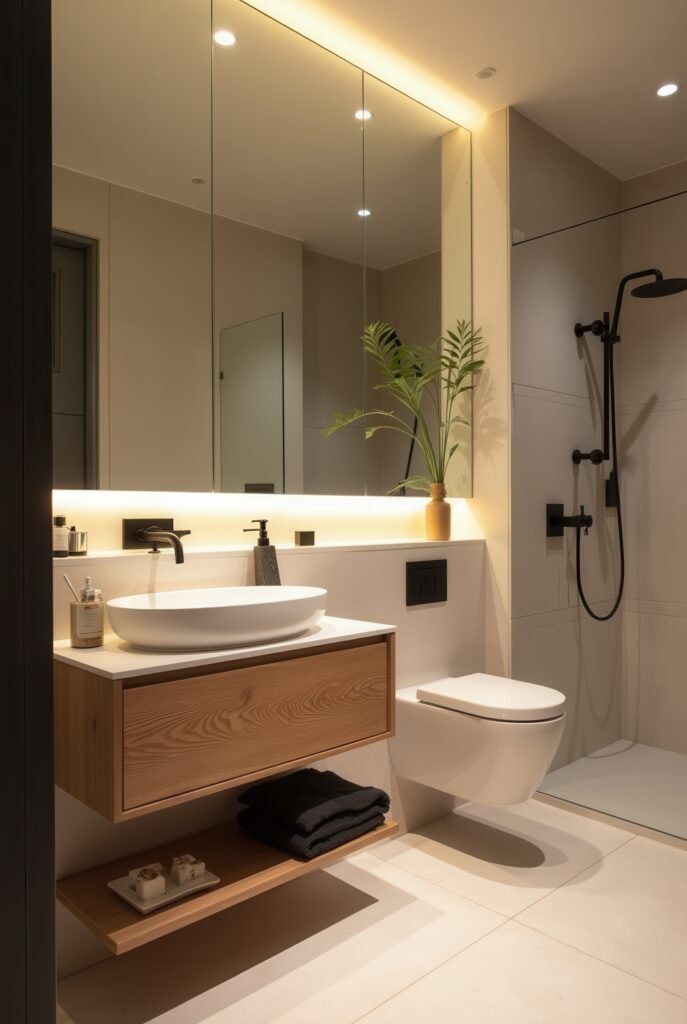
Sometimes we think we need more things. But Japandi flips that. It says: own fewer fixtures, and make them count.
- Curated Essentials: A single large mirror can replace multiple smaller ones. A wall-mounted toilet can save over a foot of floor space.
- Multi-Functional Heroes: Heated towel rails that also warm your robe? Yes, please. Or vanities with built-in hampers so your laundry doesn’t take over the floor.
- Clutter-Free Surfaces: No more endless countertop chaos. Try magnetic walls for grooming tools, under-vanity drawers with dividers, and recessed shower niches instead of caddies.
Materials & Textures

Japandi thrives on natural, eco-friendly materials that can stand up to humidity. Especially important if your bathroom fan is basically a small window that barely opens (hello, city life).
| Japanese Elements | Scandinavian Counterparts |
|---|---|
| Bamboo shower mats3 | Wool bath rugs |
| Slate wall tiles | Pale oak flooring |
| Hand-thrown pottery | Cast concrete sinks |
- Sustainable Woods
- Teak for shower benches (naturally mold-resistant).
- Bamboo for vanity fronts (great vertical grain to visually heighten the room).
- Cork for floor tiles (absorbs sound, easy to install as floating tiles—super helpful if you have neighbors below).
- Stone Textures
- Honed Marble: Matte finish hides water spots. Just don’t clean it with super acidic products.
- Terrazzo: Uses recycled glass chips. Great for small spaces because the speckled pattern helps hide soap scum.
- Basalt: Naturally antimicrobial. Perfect for shower floors if you can swing it.
- Organic Textiles
- Linen Shower Curtains: Mold-resistant and get softer over time.
- Hemp Bath Mats: Dry faster than cotton (vital if you can’t throw it in a dryer easily).
- Waffle-Weave Towels: Cozy, but not bulky to store.
- Renter-Friendly Hacks
- Peel-and-stick cork tiles (no damage).
- Temporary bamboo wraps to hide ugly cabinets.
- Magnetic shelves that clamp onto shower frames—no drilling needed.
Color Theory and Lighting in Japandi Bathrooms
Earth-Toned Palettes for Spatial Harmony
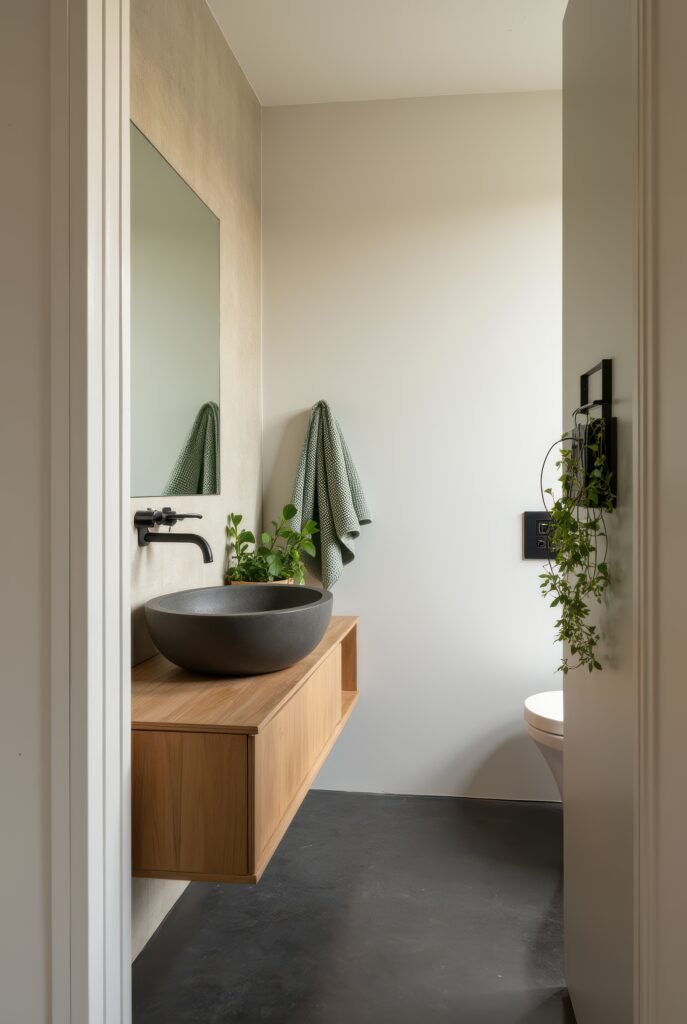
Japandi loves nature-inspired colors: soft greys, warm beiges, creamy whites. These hues trick the eye into seeing a bigger space.
- Tonal Layering: Go from darker floors to lighter walls to a white ceiling. This upward gradient makes the room look taller.
- Hint of Green: A subtle sage towel or plant can add a soothing pop of color without breaking the neutral vibe.
(Quick note: A study in the journal Frontiers in Psychology found natural textures and colors can reduce a sense of confinement. Pretty cool, huh?)
Layered Lighting for Mood and Utility
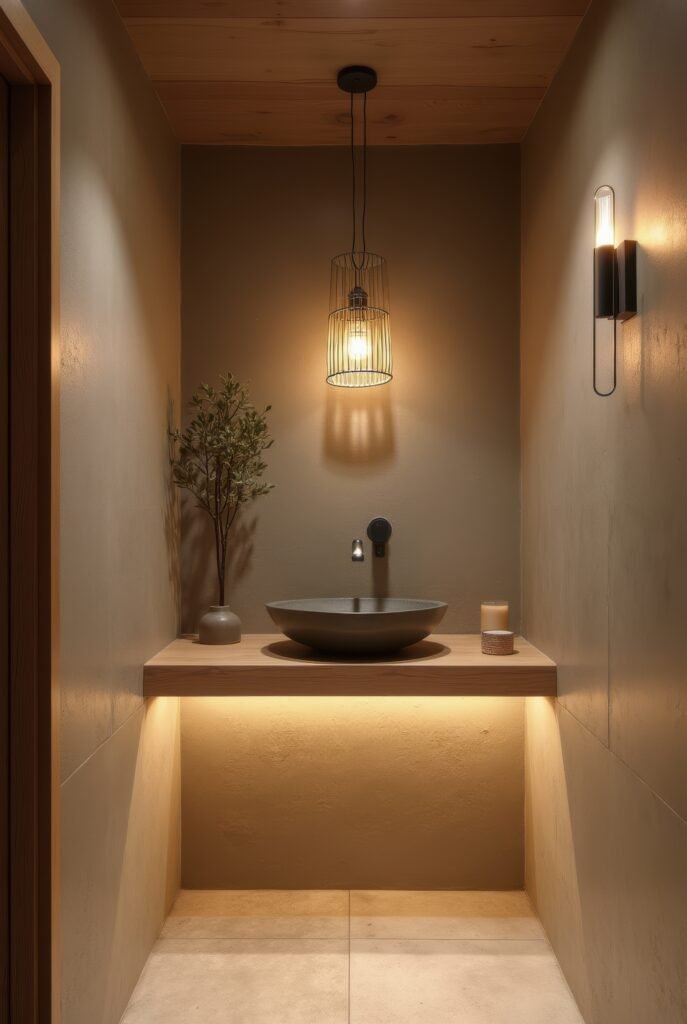
Lighting isn’t just about seeing where you’re stepping. It affects how you feel in a space.
- Task Lighting: LED strips under your vanity for grooming, recessed lights in the shower so you’re not standing in the dark.
- Ambient Glow: A dimmable ceiling fixture or a plug-in pendant light (if you can’t hardwire) helps you set the mood.
- Accent Highlights: Think a small wall sconce to show off that textured basin or a vertical wood slat wall. Makes it feel fancy without going overboard.
Strategic Light Reflection
Mirrors = your secret weapon. A tall mirror placed across from a window doubles the natural light. Even in a windowless bathroom, mirrored cabinets can bounce light around better than a single overhead fixture.
Minimalist Fixtures with Maximum Impact
Water-Efficient Geometric Designs
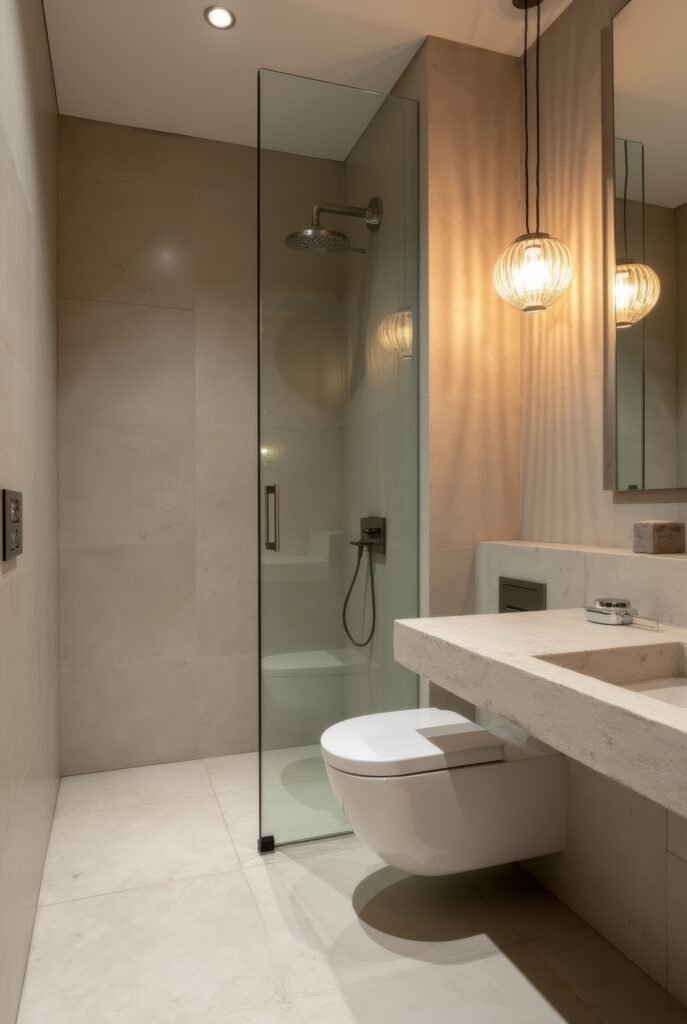
- Wall-Mounted Toilets: They “float” above the floor, creating the illusion of more space. Plus, many models use less than a gallon per flush.
- Linear Drains: Sleek, stainless strips along one edge, making your shower look bigger and easier to clean.
- Single-Lever Faucets: One handle, one job—controlling both hot and cold water. Less clutter, fewer drips.
Ergonomic Considerations for Small Spaces
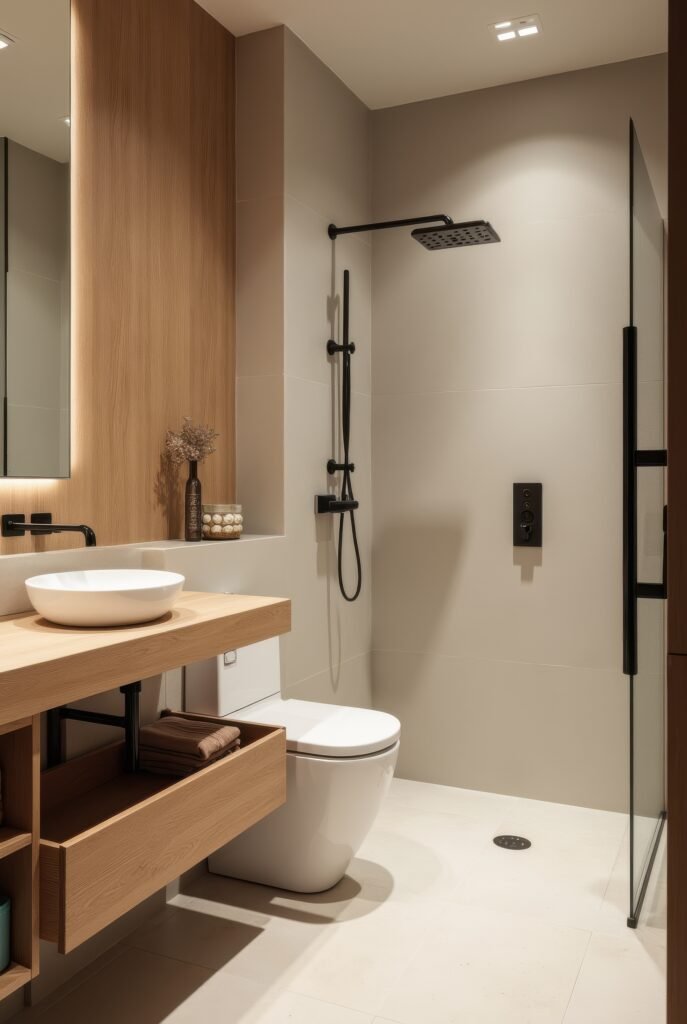
- Vanity Heights: Different households have different needs. Adjustable or 32-inch models with a built-in kid step stool can be a game-changer.
- Curbless Showers: No step to trip over, and your tiny bathroom suddenly feels more open.
- Hidden Outlets: Tucked away in drawers or behind doors, so your counters stay clear.
(Renter tip: Try adhesive hooks for towels or curved shower rods for extra elbow room—no permanent drilling required.)
Integrating Nature into Urban Bathroom Sanctuaries
Biophilic Design Elements
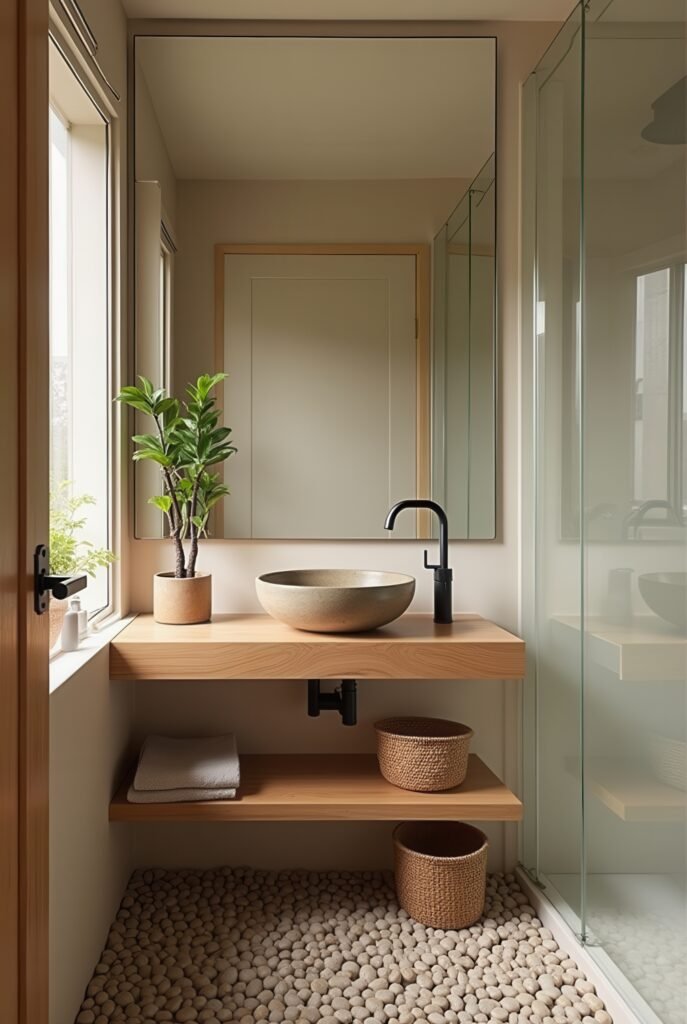
Bringing the outdoors inside is a sure-fire way to make a cramped apartment bathroom feel more refreshing.
- Low-Light Plants: Snake plants, pothos, or staghorn ferns love humidity and don’t need direct sunlight.
- Vertical Gardens: If you’re feeling adventurous, consider a preserved moss wall or tiered planters.
- Pebble Textures: Shower floors with smooth river stones give you a mini foot massage (though remember to seal them well).
Sensory Water Features
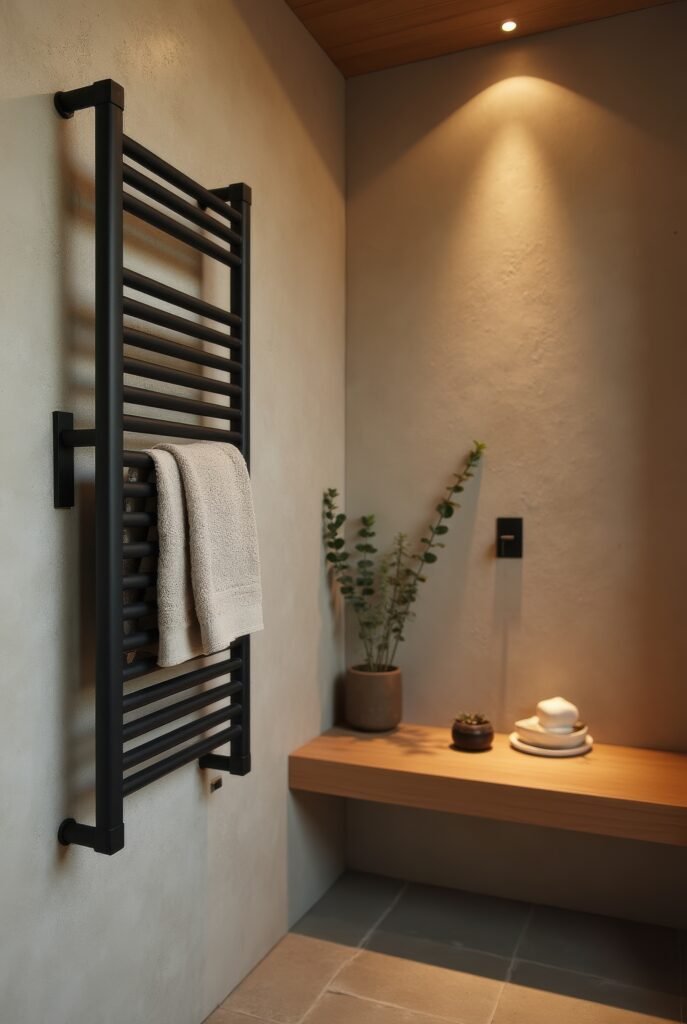
- Recirculating Bamboo Fountains: The trickling sound can calm your nerves after a stressful day.
- Heated Towel Racks: Adds that cozy factor. And if you hang eucalyptus on it, the steam releases a spa-like aroma.
- Shower Bench: Great for shaving, or just sitting with the water hitting your back. Also doubles as a stage for small succulents (I keep an aloe plant for tiny cuts and scrapes).
Maintaining the Japandi Bathroom Ecosystem
Material Preservation Techniques
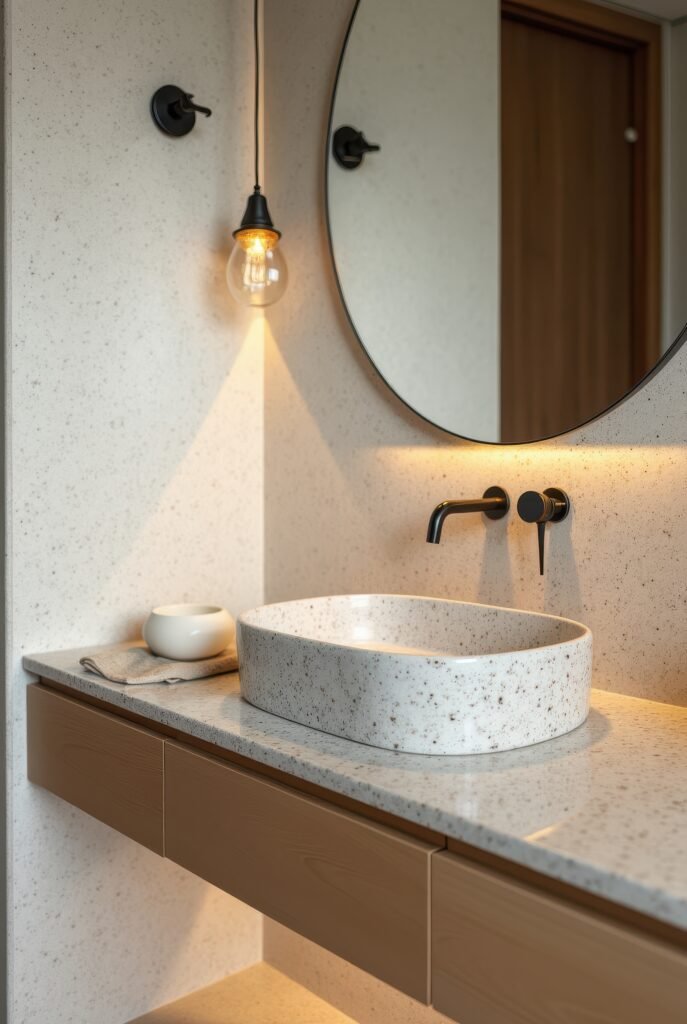
Japandi bathrooms look amazing, but they need a little TLC to stay that way—especially with all that natural wood and stone in a humid environment.
- Stone Sealing & Care
- Honed Marble: Reseal about every six months. Use pH-neutral cleaners, avoid vinegar or lemon-based products.
- Terrazzo: A penetrating sealer once a year, and a quick wipe after each shower helps prevent water spots.
- Basalt Floors: Scrub gently with baking soda paste to keep slip-resistance.
- Wood Treatment
- Teak: Rub on teak oil every few months to keep it from drying out.
- Bamboo: Wax it twice a year so it doesn’t warp.
- Reclaimed Oak: A little sanding and linseed oil once a year keeps it looking rustic-chic, not just rustic.
(One hack: leftover coffee grounds can work as a mild abrasive for wooden surfaces—just test a small patch first.)
Adaptable Design for Changing Needs
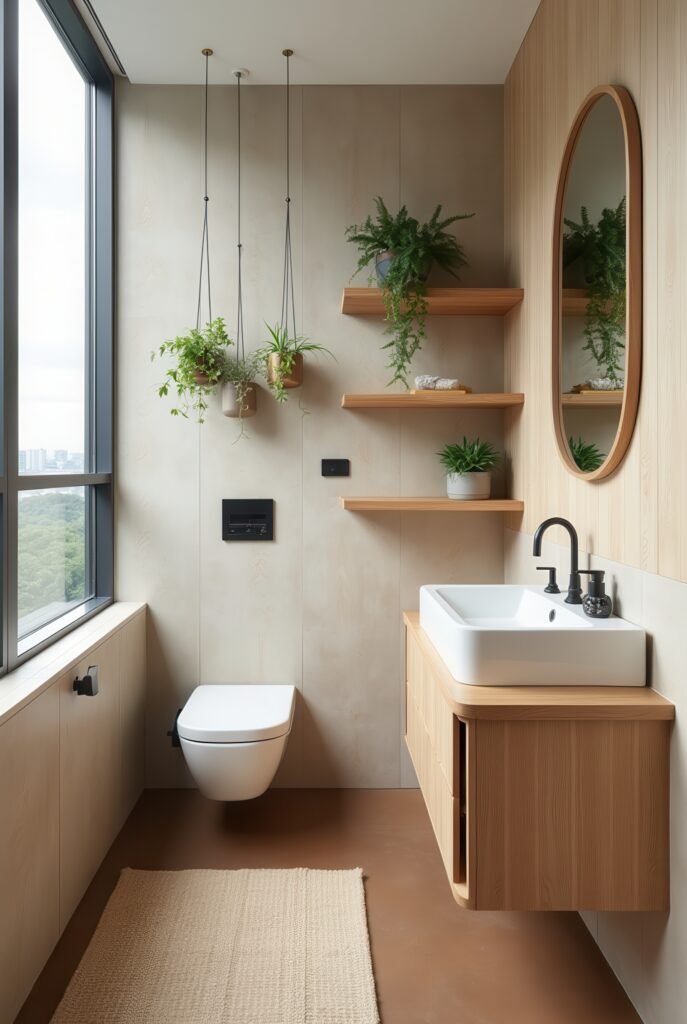
Japandi is all about flexibility. Your life changes, so your bathroom should adapt too.
- Modular Storage: Adjustable shelving or magnetic wall panels let you swap out items as needed (new baby? no problem!).
- Interchangeable Textiles: Switch out shower curtains, rugs, and towels with the seasons.
- Renter-Friendly Upgrades: Tension rods for hanging planters, peel-and-stick backsplashes, magnetic shelf brackets for easy add-ons.
If you move or want a refresh, you can repurpose these materials, donate them, or pass them along to fellow design fans. Trust me, there’s always someone who wants your funky bamboo shelves.
Final Thoughts
So here’s the big takeaway from this whole Japandi Bathroom idea:
- You can transform even the smallest bathroom into a calm retreat by mixing simple lines with cozy touches.
- Natural materials and soft, neutral colors do wonders for making tight spaces feel bigger (and more inviting).
- Decluttering can actually be fun when it means fewer objects but better ones—like a single statement mirror instead of a cluttered shelf of random stuff.
What next? If this style feels like your vibe, try visiting a local thrift store or home goods shop to find unique pieces (like a rustic wood shelf or a sleek stone tray). Look for ways to bring in plants that thrive on humidity. Or hunt down some peel-and-stick tiles if you’re renting and can’t make permanent changes.
Before you know it, you’ll have a bathroom that feels more like a spa. And if you try out any of these ideas, I’d love to hear how it goes—mostly because I’m always on the lookout for new tips myself (I still haven’t nailed the perfect plant setup).
That’s all for now. This article is complete, and I hope it helps you create a refreshing, minimalist space that’s all about calm vibes and zero clutter. Enjoy your little slice of serenity!
